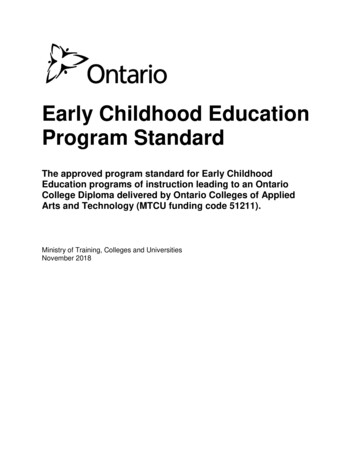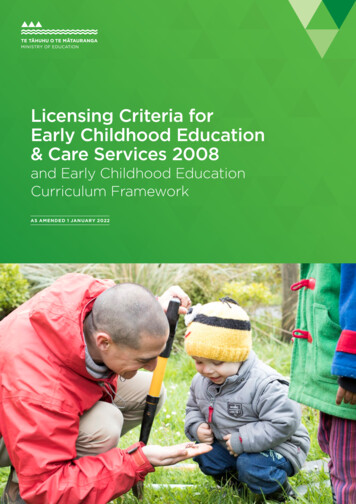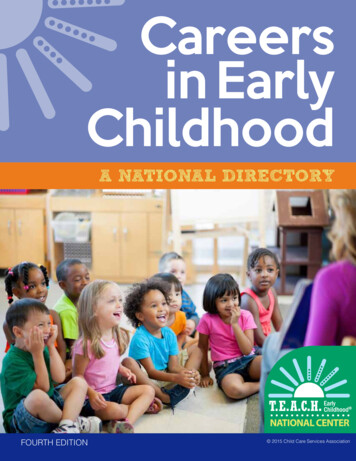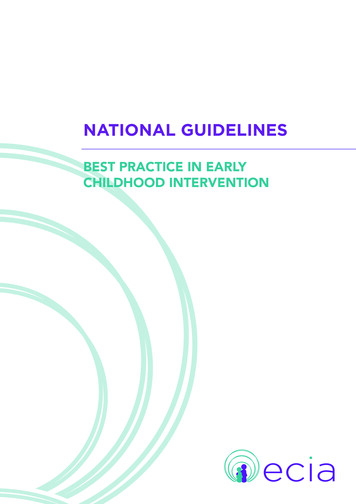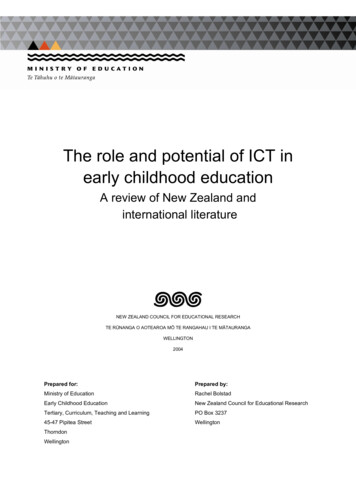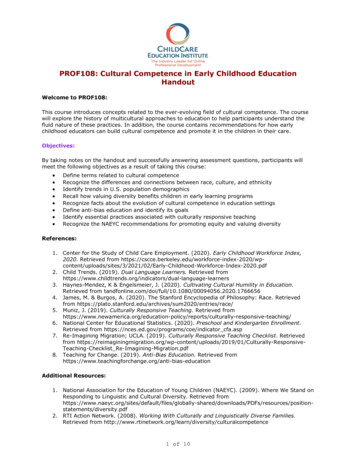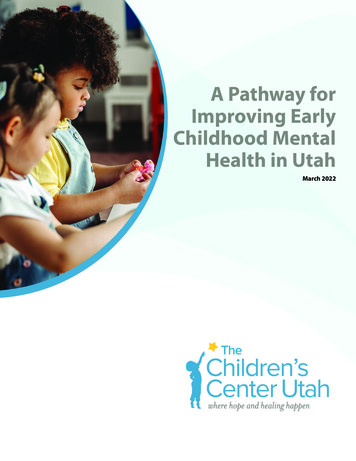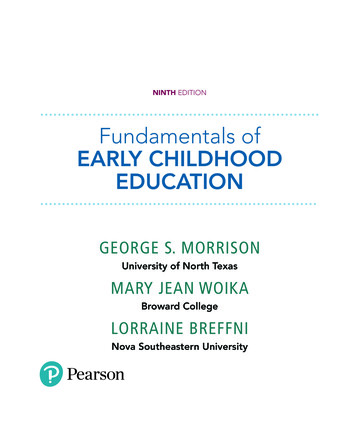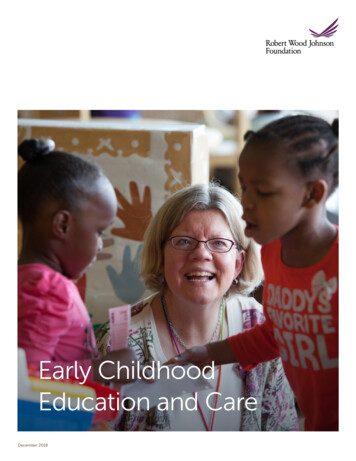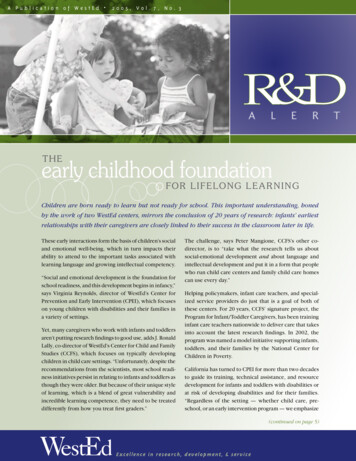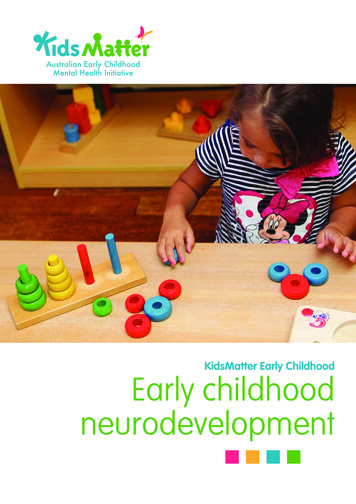
Transcription
KidsMatter Early ChildhoodEarly childhoodneurodevelopment
Acknowledgement:KidsMatter Australian Early Childhood Mental HealthInitiative has been developed in collaboration withbeyondblue, the Australian Psychological Societyand Early Childhood Australia, with funding fromthe Australian Government Department of Healthand beyondblue.Disclaimer:While every care has been taken in preparingthis publication, Beyond Blue Ltd, The AustralianPsychological Society Limited, Early ChildhoodAustralia Inc. and the Commonwealth of Australiado not, to the extent permitted by law, accept anyliability for any injury, loss or damage suffered byany person arising from the use of, or reliance upon,the content of this publication.Important Notice:KidsMatter Australian Early Childhood MentalHealth Initiative and any other KidsMatter mentalhealth initiatives are not to be confused with otherbusinesses, programs or services which may alsouse the name ‘Kidsmatter’.Copyright Commonwealth of Australia 2014This work is copyright. Provided acknowledgmentis made to the sources, early childhood educationand care services are permitted to copy materialfreely for communication with teachers, staff,parents, carers or community members. You mayreproduce the whole or part of this work in unalteredform for your own personal use or, if you are partof an organisation, for internal use within yourorganisation, but only if you or your organisation donot use the reproduction for any commercial purposeand retain this copyright notice and all disclaimernotices as part of that reproduction. Apart from rightsto use as permitted by the Copyright Act 1968 orallowed by this copyright notice, all other rights arereserved and you are not allowed to reproduce thewhole or any part of this work in any way (electronicor otherwise) without first being given the specificwritten permission from the Commonwealth to do so.Requests and inquiries concerning reproduction andrights are to be sent to the Communications Branch,Department of Health, GPO Box 9848, CanberraACT 2601, or via e-mail to copyright@health.gov.au.While the resources are available freely for thesepurposes, to realise the full potential of KidsMatterEarly Childhood, it is recommended that theresources be used with the appropriate training andsupport under the KidsMatter Initiative.
Contents3Introduction4Recommended reading6KidsMatter Early ChildhoodEarly childhood neurodevelopment eBook map8The importance of the early years10Brain development begins in utero14Early childhood development occurs in thecontext of relationships8 Children develop in the context of relationships9 Children learn by interacting, observing and practising9 Stress can affect children’s brain development12 The organisation of brain cells12 Significant milestones of foetal brain development13 The brain develops rapidly in the first five years14 Warm, responsive and trusting relationshipsstimulate brain development15 Warm, responsive and trusting relationshipspromote learning15 Children explore and learn when they feel safe16Early experiences shape children’s neurodevelopment18Children’s mental health and wellbeing is essentialfor brain development16 Brain development occurs when neurons form connections17 The brain is most sensitive to input while it is developing18 The brain is highly interconnected19 High levels of stress interfere with brain development21Children learn by interacting, watching others and practising21 Early relationships provide a model for children’s brain development22 Children build their brains through play23Development of children’s social and emotional skills23 How relationships promote brain development24 Limited opportunities of warm, responsive and trusting relationshipsaffect children’s development1KidsMatter Early Childhood4 Other resources that may be of interestEarly childhood neurodevelopment3 Welcome to KidsMatter Early ChildhoodEarly childhood neurodevelopment eBook
Early childhood neurodevelopmentContentsKidsMatter Early Childhood225The development of language27The development of learning and memory29The development of self-regulation, planning and organisation32The development of sensory motor skills25 Language development occurs in relationships25 What does language look like in early childhood?26 The brain and language development26 Supporting language development27 Learning and memory in the brain28 Supporting learning and memory30Development of the executive functions30Supporting executive function development31 The executive functions oversee all areas of development32The senses32 Integration of sensory and motor skills33 Supporting sensory motor development34 Motor planning and coordination relies on the senses35Summary36References and resources39Glossary
This eBook focuses on early childhood brain development.The aim of the eBook is to demonstrate how the braindevelops from conception to five years.The eBook content provides a general understanding of someof the key features of neurodevelopment in the early years. Ithas been specifically written for early childhood education andcare (ECEC) educators, but is useful for a range of audiencesinterested in early childhood neurodevelopment. Each sectionincludes a summary of content about specific aspects ofdevelopment. Links to other written and multimedia resourcesrelated to content in each section have also been included forthose who want to learn more or go deeper.We encourage you to use this eBook to support your ongoinglearning and professional development. We hope you enjoythe resource.3KidsMatter Early ChildhoodWelcome tothe KidsMatterEarly childhoodneurodevelopment eBookEarly childhood neurodevelopmentIntroduction
RecommendedEarly childhood neurodevelopmentreadingKidsMatter Early Childhood4KidsMatter Early Childhood: A framework for improvingmental health and wellbeing.Other resources that maybe of interest include:Everyday Learning Series by Early Childhood AustraliaThe Everyday Learning Series focuses attention on the everydayways in which young children—babies, toddlers, preschoolers—canbe supported in their growth and ryday learning series.html.These resources can be purchased for a small cost from EarlyChildhood Australia.Books in the series that are relevant to early childhoodneurodevelopment include: Everydaylearning about sensory learning Everydaylearning about executive function in the early years Everydaylearning - Physical activity—helping children grow Everydaylearning about babies as amazing learners Everydaylearning about responding to the emotional needsof children Everydaylearning about play and learning Everydaylearning about making the most of your environment Everydaylearning about reading and writing Everydaylearning about confidence and coping skills Everydaylearning about maths Everydaylearning about imagination
Books in the series that are relevant to earlychildhood neurodevelopment include: Learningand teaching through play TheCircle of Security: Roadmap to buildingsupportive relationships Discovering Youngletters and soundschildren as active learners.Information for families and earlychildhood staff: Component 2 Developingchildren’s social and emotional skills,KidsMatter Early Childhood: Helpingchildren manage their emotions Helpingchildren learn to make decisions Curiosityand confidence: Developingmotivation Childrenand play Managinglife’s ups and downs.Information for families and earlychildhood staff: Component 4 Helpingchildren who are experiencingmental health difficulties, KidsMatterEarly Childhood: Keepinga balance: Managing feelings andbehaviours Whentimes get tough: Managing traumaand ways to sheet-index-0.Raising Children NetworkThe Raising Children Network is a nationalwebsite which provides articles on a range ofissues relevant to children’s development.www.raisingchildren.net.au.Changing BrainsChanging Brains is a DVD for parents andeducators which presents an evidencebased discussion about the brain and how itdevelops.www.changingbrains.org.Brain rules for babyBrain rules for baby is a DVD about supportingchildren’s brain development from birth to by.Early childhood neurodevelopmentThe Research in Practice Series providespractical, easy-to-read resources for thoseinvolved in the early childhood field. Thebooks are designed to assist with thosechallenging issues which arise in thecare and education of young children, byoffering effective, new approaches. www.earlychildhoodaustralia.org.au/research inpractice series.html.KidsMatter Early Childhood resources5KidsMatter Early ChildhoodResearch in Practice Series byEarly Childhood Australia
Early childhood neurodevelopmentKidsMatterEarly Childhoodneurodevelopment eBook mapSECTIONMAIN MESSAGESThe importance ofthe early years EarlyKidsMatter Early Childhood6experiences shape children’s brain development and canhave a lasting effect on mental health and wellbeing. Positiverelationships and rich learning environments promotechildren’s development. Earlyadverse experiences may alter child’s developmentalprogress. ChildrenBrain developmentbegins in utero Thelearn by interacting, observing and practising.anatomy of the brain and neuron. Braindevelopment begins after conception in a sequentialmanner. Experiencesmatched with children’s neurodevelopmental levelpromote learning.Early childhooddevelopment occursin the context ofrelationships RelationshipsEarly experiencesshape children’sneurodevelopment TheChildren’s mentalhealth and wellbeingis essential for braindevelopment Healthyprovide children with opportunities for engagementwhich are essential for early brain development. Warm,responsive and trusting relationships help children to feelsafe and explore their environment.development of the brain is use dependent. This meansthat it requires particular experiences and stimulation to formconnections which correspond to specific skills/functions.brain development is dependent on positive social andemotional wellbeing. Highlevels of stress interfere with brain developmentand function. Earlypredictable warm and trusting relationships can promotebetter outcomes for children at risk of high stress.
Children learnby interacting,watching others andpractising EarlyDevelopment ofchildren’s social andemotional skills PositiveThe development oflanguage Languagerelationships allow children to engage and attend which arenecessary for learning. Play Asignificant caregiver’s emotional attunement with a childsupports development of self-regulation.goes through marked development in early childhood. Researchindicates that there is a critical period for languagedevelopment. Languagedevelopment occurs in a social context, thereforechildren learn language by listening to it and using it.The development oflearning and memory Theprocess of learning takes place when repeatedexperiences promote the development of neuron networks. Opportunitiesto practise tasks that require memoryimprove learning.The developmentof self-regulation,planning andorganisation ExecutiveThe development ofsensory motor skills Refersfunctioning refers to the range of higher ordercognitive skills associated with self-regulation and goal-directedbehaviours. Theseskills are essential for learning, developing relationshipsand adapting to the environment.to the ability to integrate sensory and motor information tocomplete actions. Childrendevelop sensory motor skills through play, by practisinggross and fine motor movements and completing tasks thatrequire them to think about where objects are located in space.SummaryReferences and resourcesGlossary7KidsMatter Early Childhoodrelationships are at the core of children’s social andemotional development.Early childhood neurodevelopmentis how children learn and make sense of their world.It allows them to practise skills in all learning domains whichstimulate brain development.
The importanceEarly childhood neurodevelopmentof the early yearsKidsMatter Early Childhood8Early experiences shape children’s brain development andcan have a lasting effect on mental health and wellbeing.The brain has critical and sensitive periods when particularexperiences are necessary to stimulate development ofspecific brain functions. Many of these experiences occurthrough children’s relationships with their families andsignificant caregivers. This means that relationships areessential for children’s learning and development.Children develop in thecontext of relationshipsFrom the time they’re born, babies rely on the adultsaround them to meet their physical and emotional needs.It is through the moments of feeding, changing, bathingand play that children build relationships with their familiesand other adults who care for them. Warm, responsiveand trusting relationships help children feel safe andsecure to explore the world around them. Childrenlearn from their relationships and their opportunitiesto explore as they provide the stimulation needed topromote brain development.
Stress is a natural part of life and inmany instances can be motivating. It iswhen stress becomes frequent, severeand ongoing, that it becomes damaging.Unfortunately, some children are borninto circumstances where experiences ofhigh stress are common. Chronic stress—stress that occurs often over long periodsof time—affects children’s relationshipsand puts them at great risk of altered braindevelopment. Acute and chronic stress canbecome toxic. Experiences of toxic stressmake it difficult for children to engage intheir relationships and learning. In highdoses, the hormones released during thestress response can have a damagingeffect on brain cells.How brains are built: The corestory of brain pment.Early childhood neurodevelopmentChildren learn from birth. When theirsignificant caregivers provide nurturingcare, they learn that their actions, suchas crying, cooing and fussing lead toa response to their needs, such asfeeding, interacting and being put to bed.These give-and-take interactions are afoundation for brain development. Theygive children models of how to interact withothers in their environment and providethem with a basis for learning new skills.They watch those around them, absorbinformation from their interactions andpractise what they learn through their playand behaviour.Stress can affectchildren’s braindevelopment9KidsMatter Early ChildhoodChildren learnby interacting,observing andpractising
Early childhood neurodevelopmentBraindevelopmentKidsMatter Early Childhood10begins in uteroBrain development begins in the womb, with most ofthe structural features of the brain formed by the eighthweek of conception. These structures continue to growand develop throughout pregnancy and after birth.Brain development occurs in a sequential manner, withlower and more primitive areas developing first followedby the higher cerebrum which is responsible for morecomplex functions. The main structures of the brain havebeen associated with particular functions; however, therelationship between brain structure and function is not asimple one. Most functions occur through communicationbetween multiple brain areas through interconnectednetworks of neurons.
The brain can be divided into three major parts:Brain stem and cerebellum: connectsresponsible for basic survival functions such as breathing, heart rate and blood pressureattached to each other and together are involved in balance and coordination functions.Limbic system: sitson top of the brain stem relayssensory information isresponsible for a range of functions including: emotion, fear, hunger, thirst, learning andmemory and circadian rhythms, which are responsible for regulating sleep and waking,hormones and temperature.Cerebral cortex: isthe largest part of the brain, sitting on top of the limbic system hasa right and left hemisphere, divided into four lobes:{{occipital{{temporal{{parietallobes: control of visionlobes: hearing, language and social understandinglobes: bodily sensations, including heat, cold, pressure and pain{{frontallobes: memory, abstract thinking, planning and self-regulation. The outermostsection of the frontal lobes, known as the prefrontal cortex, is where more complex orexecutive functions occur, such as attention, motivation and goal-directed behaviour.ZERO TO THREE: Baby brain elopment/baby-brain-map.html.Early childhood neurodevelopment are11KidsMatter Early Childhood isthe brain to the spinal cord
Early childhood neurodevelopmentThe organisationof brain cellsKidsMatter Early Childhood12The brain is made up of nerve cells knownas neurons. Neurons communicate witheach other using electrical signals. A neuronconsists of a cell body, protruding branchesknown as dendrites and an axon. Anaxon may have multiple terminals whichlink to dendrites of other neurons to conveymessages through electrical signals. Thepoints at which axon terminals and dendritesmeet are known as a synapses. Dendritesreceive incoming messagesfrom neurons, while the axon sendsoutgoing messages via chemicals calledneurotransmitters to other neurons. Axonsare often coated with a fattysubstance known as myelin. Myelin helpselectrical messages to move faster from oneneuron to the next. Themyelination of axons occurs from thefoetal period into early adulthood, and itis because of this process (and only thisprocess—adults and children’s brains arethe same size) that adults can do morecomplicated tasks than children.Significantmilestonesof foetal braindevelopmentFirst trimester: Theneural tube forms from a plate ofspecialised cells which will develop intothe brain and spinal cord. Thefirst neurons and synapses beginto form in the spinal cord, leading to firstfoetal movements.Second trimester: Ridgesand indentations in the brainsurface begin to appear. Thickeningof cerebral cortex andformation of synapses. Myelinationof axons commences.Third trimester: Cerebralcortex begins to take over someof the functioning from the brain stem. Cerebralcortex begins to supportearly learning.
The brain developsrapidly in the firstfive yearsstem most highly developed area. Significantdevelopment of the vision areas of the brain. Recognisehuman faces and can discriminate between facialexpressions of emotion. Recognise Evidencefamily members’ and significant caregivers’ voices.of early sensory motor skills. Furtherdevelopment oflanguage areas of the brainand interconnection withother regions. Greatersophistication inlanguage abilities. GreaterBabies: Developmentof head control and early motor skills suchas rolling over and sitting. Visualareas of the brain develop leading to fullbinocular vision. Significantgrowth in the areas associated with learningand memory. Language Increasecircuits strengthen.in sensory motor skills.Toddlers: RapidPreschoolers:integration ofsensory and motor areas,related to abilities in finemotor skills. Greatercapacity tomanage emotions. Developmentof frontallobes, associated withgreater skills in reasoningand understanding ofcomplex ideas.development of motor skills. Languageareas experience increased development ofsynapses and interconnection. Significantincrease in children’s language abilities,vocabulary often quadruples between ages one and two. Increasedability to complete more complex tasks. Developmentto make sense of past events and understanding ofconsequences of actions improve.capacity for complex thought and cognitive flexibility. Developmentwww.youtube.com/watch?v uOsgDkeH52o.of recognition of the self and self-awareness. Ability GreaterChild TraumaAcademy Seven SlideSeries—The humanbrainof brain areas associated with grossmotor abilities.Baby center: Inside achild’s l-guide.13KidsMatter Early Childhood BrainEarly childhood neurodevelopmentNewborns:
Early childhood neurodevelopmentKidsMatter Early Childhood14Earlychildhooddevelopmentoccurs in the contextof relationshipsRelationships provide children with opportunities forengagement which are essential for early brain development.Warm, responsive and trusting relationships provide theoptimal conditions for children to learn and make sense of theworld around them.Warm, responsive andtrusting relationshipsstimulate braindevelopmentChildren are born with the need to connect to others. Their firstrelationships with their families provide the basis for children’ssocial and emotional learning. Areas of the brain associated withsocial and emotional functioning develop via the interactions thatoccur with significant caregivers. Children learn about their ownminds when they see themselves represented in someone else’smind, and this helps them learn how to respond to others andmanage their emotions through the responses they receive fromthose around them.
KidsMatter Early Childhood: Growing together in ing-together-relationships.Center on the Developing Child, Harvard University: Young children develop in anenvironment of sources/reports and working papers/workingpapers/wp1/.Child Trauma Academy—Child development and early dev-early-childhood/.KidsMatter Early Childhood: Module 3—Relationships and children’s nent2-professional-learning/module-3.Early childhood neurodevelopmentWarm, responsive and trusting relationshipswith families and significant caregivers providechildren with opportunities for give-and-takeinteractions. For example, a child might ‘give’babbling sounds to their family member andthey might ‘take’ encouraging words fromtheir family member. This shows children thatwhen they complete a particular action it leadsto a particular response. This is the basis ofchildren’s learning—they realise that theiractions correspond with specific outcomes.Children feel a sense of safety when theirrelationships are warm, responsive andtrusting. Their sense of safety comes fromnurturing, predictable and calm environments,where the adults around them attend totheir physical, social and emotional needs.When children feel safe they can try newthings and feel supported in their attempts todevelop new skills. It provides them with theconfidence to explore their environment anddrive their own learning. When a baby knocksa hanging mobile, the mobile plays music. Ifthey try to knock it again and it plays musicthey learn that they can make the mobileplay music by knocking it. When an adulttakes delight in this achievement, the baby’sbehaviour is encouraged further. Repeatedexperiences such as these promote children’slearning and development.15KidsMatter Early ChildhoodWarm, responsiveand trustingrelationshipspromote learningChildren exploreand learn whenthey feel safe
Early childhood neurodevelopmentEarlyexperiencesKidsMatter Early Childhood16shape children’sneurodevelopmentThe development of the brain is use dependent. Thismeans that it requires particular experiences to promoteneuron connectivity and the development of brain areas.Connections are strengthened when these experiences arerepeated over time.Brain developmentoccurs when neuronsform connectionsWhen neurons form connections with other neurons, theydevelop networks which correspond with various skills.For example when a child is learning to ride a bike, theskills required to ride, such as balancing, pushing pedalsand watching ahead need to be integrated and storedin memory. This happens with repeated opportunities topractise these skills. So, when a child comes back to ridingon another day, the networks developed are activated,allowing them to get on the bike and ride without muchthought.Connections between neurons that are stimulated throughexperience are strengthened, while those that are not arelost. So if a child spent a day learning how to ride a bike anddidn’t get a chance to get on the bike again for an extendedperiod, they may need to practise the skills needed forriding all over again.
There are some areas of brain developmentwhich are genetically programmed anddepend on experiences to be activated.These require environmental stimulation ata particular time in development (known asa sensitive period) to activate specific brainfunctions (e.g. vision and language). If theexperiences (e.g. visual stimuli, hearinglanguage) are absent or limited, developmentof specific networks can be compromised,leading to poor functioning in particular areas(e.g. seeing, communicating).The brain can also adapt to stimulation thatdoes not rely on genetic programming. Thisoccurs when repeated experiences from theenvironment provide the brain with stimulation,forcing it to adapt and change (e.g.becoming skilled in playing an instrument ormathematical ability). This results in individualdifferences in brain ex.php/resources/reports andworking papers/working papers/wp5/.Center on the DevelopingChild, Harvard University: Earlyexperiences can alter geneexpression and affect .edu/index.php/resources/reports andworking papers/working papers/wp10/.Early childhood neurodevelopmentThe types of experiences received during theearly years have the greatest impact on braindevelopment than any other stage of life.This is because the brain is most sensitive tostimulation from the environment during thistime.Center on the Developing Child,Harvard University: The timingand quality of early experiencescombine to shape brainarchitecture17KidsMatter Early ChildhoodThe brain ismost sensitive toinput while it isdeveloping
Early childhood neurodevelopmentChildren’smental healthKidsMatter Early Childhood18and wellbeing is essential forbrain developmentHealthy brain development is dependent on positive social and emotional wellbeing.Children who feel good about themselves and can cope with challenges can make themost of learning and development opportunities.The brain is highly interconnectedThe relationship between brain structure and function is complex. There are areas of thebrain that dominate particular functions (e.g. occipital lobes and vision), however, all areasof the brain are interconnected via networks of neurons which work together to support arange of processes and functions. Research has shown that brain areas related to emotionalfunctioning can control, influence and support other functions. Emotions influence a child’scapacity to self-regulate, to attend, to be engaged and to take action, all the skills required forlearning to occur. This demonstrates that good social and emotional skills are the foundationsof optimal learning and development. Children who are able to manage their emotions andbounce back from the challenges of life have the capacity to absorb more from the learningopportunities presented to them. Without these skills, children become easily overwhelmedby their social and emotional experiences, making it difficult for them to focus their attentionon opportunities for learning. When children are feeling overwhelmed by strong emotionsmost of their mental resources are going in to managing those feelings, leaving less availablefor learning.
Abused and neglected children have oftenmissed out on the early experiences ofwarm, responsive and trusting relationshipswhich are at the foundation of healthy braindevelopment. They have sometimes hadthe experience of being hurt by the personto whom they look for protection, which canlead to uncertainty, anxiety and distress.Managing this can be very stressful, andcan become toxic to brain development.As a consequence, their brains begin todevelop in ways to cope with these situations.Research has shown that these children havea tendency to respond with high levels of fearand hypervigilance, regardless of the level ofthreat present. This means that their brainshave been primed to be on the lookout forconstant danger, and they perceive levels ofthreat to be higher.There are specific areas of the brain thathave receptors for stress hormones. Thememory and learning area of the brain(hippocampus) in particular has high levelsof receptors for stress hormones. It makessense that stress hormones attach to thisarea of the brain during stressful events,as they activate memories of dealing withprevious stressful experiences. This activatesa previous successful strategy for a newsituation. Research of abused and neglectedchildren has shown that they have smallerhippocampal volumes, which has been relatedto difficulties in learning and memory.Children who have experiencedstressful events benefit significantlyfrom warm, responsive and trustingrelationships with caring adults.Repeated opportunities for suchinteractions can help to buffersome of their stressful experiences,supporting their learningand development.Early childhood neurodevelopmentStress is a fact of life, and in many instanceshas a positive influence, as it pusheschildren to adapt to their environment anduse new skills. This supports learning anddevelopment. On the other hand, experiencesof repeated high levels of stress mean thatthere is a constant focus on managing athreat that may be present, taking attentionaway from opportunities to interact withthe environment in a way that supportsbrain development.This constant warning of threat
4 Early childhood neurodeveloment KidsMatter Early Childhood: A framework for improving mental health and wellbeing. Other resources that may be of interest include: Everyday Learning Series by Early Childhood Australia The Everyday Learning Series focuses attention on the everyday ways in which young children—babies, toddlers, preschoolers—can
